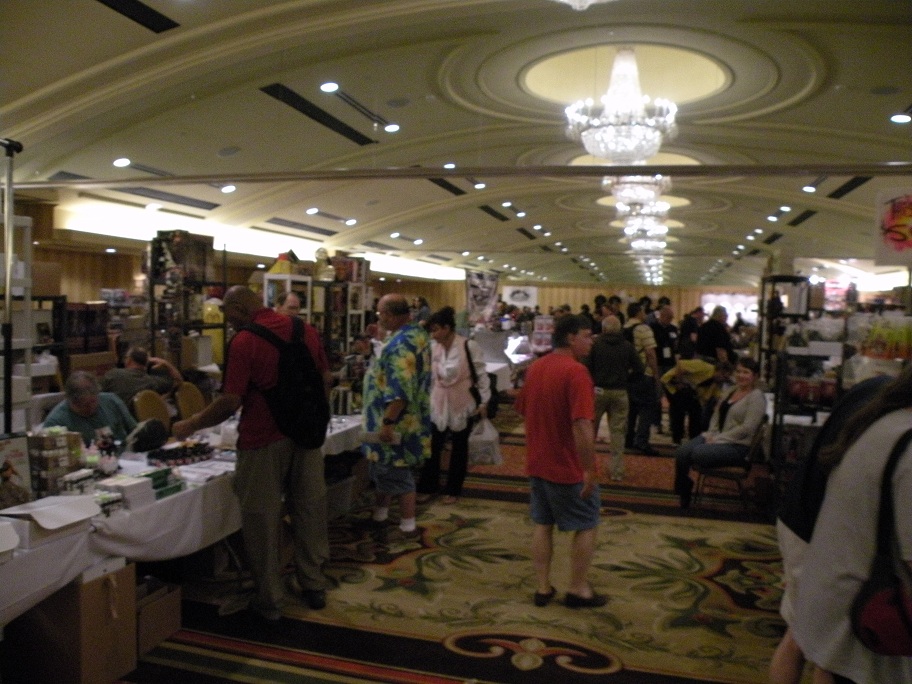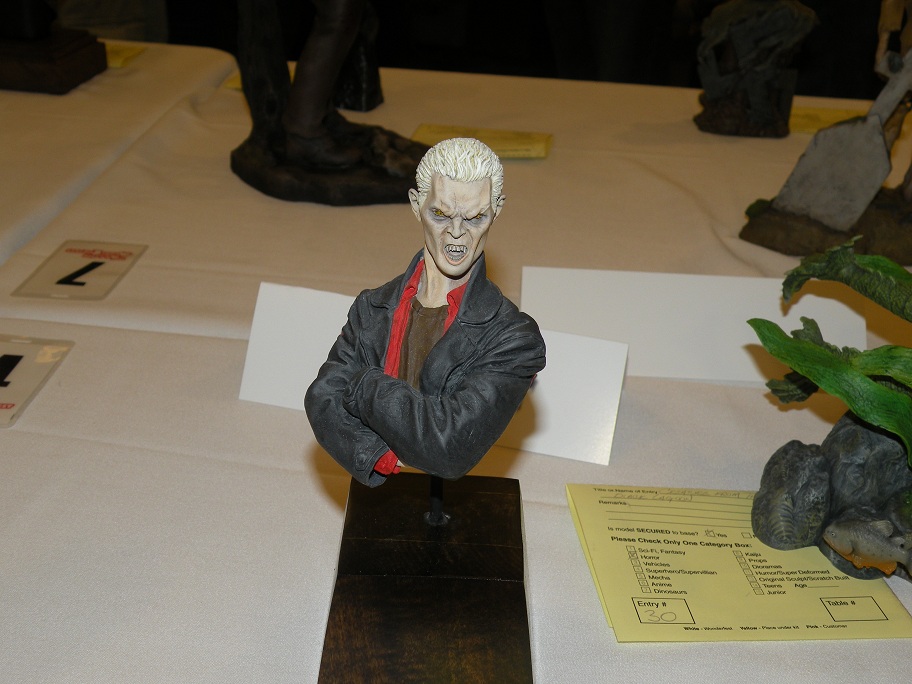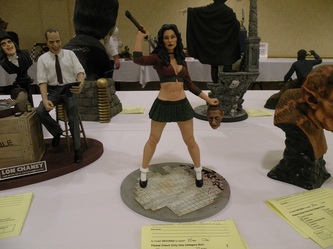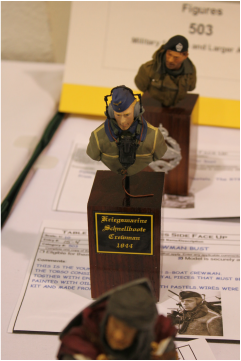|
CASM would like to honor and pay tribute to all of those men and women who have given there lives so we may have the freedoms we enjoy today. Because of others sacrifices we are able to complain about our congress and President, participate in a judicial process that can determine the life or death of others, and exercise our freedom in pursuit of happiness. Thank-you and our condolences to the families who have lost their loved ones.
The Wonderfest Hobby Expo is an annual event held in Louisville, Kentucky that focuses on figures and sci-fi vehicles, and is the largest event of this type. This year’s show took place during the weekend of May 17-19. Sponsors for this show include Amazing Figure Modeler Magazine, Mobius Models and Iwata. I attended this event with my wife Heather and Rusty Nail, who was invited to be a judge this year. Other CASM members participating in the show by proxy were Tom Brown, Kenneth Childres, Ron Leker and Dakota Leker. This event is a unique experience in the hobby of scale modeling, not only because of the focus on sci-fi, fantasy and horror, but it also includes many seminars, optional workshops and evening events. For modelers wishing to come to town a day earlier, there were day long workshops on figure painting and dinosaur models. During the actual days of the show, there were 16 demos, including topics such as color theory, working with transparents, using programmable electronics, airbrushing fleshtones, digital 3D sculpting, and getting perfect seams. Evening events included screenings of documentaries on Garry Anderson and Ray Harryhausen, and the history of the Phantom of the Opera, and well as the 1960’s horror/comedy film, The Raven, starring Vincent Price, Boris Karloff and Peter Lorre. For those that wanted to challenge their skills, there was the Iron Modeler contest, in which participants were given parts of various models to incorporate in an original piece that had to be completed within a timed period. There were several guests featured at the show, including Sara Karloff, daughter of Boris Karloff, Lee Meriwether, former Miss America and actress known for roles on Batman and Star Trek. One of the highlights of the show was Ms. Karloff sharing her memories of being on the set of The Raven with her father and screening a rare video of her father’s final interview. Also on hand were prop designer John Eaves (Star Trek: Into Darkness, Iron Man 3), makeup artist John Goodwin (CSI, Men in Black, The Thing), CGI effects artist Lee Stringer (Battlestar Galactica, Firefly, Star Trek: Voyager) and model-maker Randy Cooper (Stargate, Starship Troopers). All of these great guests gave presentations. There were two large dealer’s rooms. Vendors included Mobius Models, Round 2 Models, Iwata, Badger, Starship Modelers, CultTV Man, JT Graphics, Resin Crypt, and Model Mansion. The size of the rooms and variety of merchandise has to be seen to be believed! Paints by ComArt and Feakflex, imported kits not available in the US, and rare garage kits are just a few examples. One must have great will power to not spend beyond one’s budget when attending this show. The Amazing Model Contest featured somewhere around 550 models, although an exact number was never announced. Categories include Horror Figures, Sci-fi/Fantasy Figures, Super Heroes/Villains Figures, Anime, Vehicles, Mecha, Dinosaurs, Kaiju (giant monsters, e.g. Godzilla, Mothra), Props, Dioramas, Humor/Super Deformed, Original Sculpt/Scratchbuilt, and, of course, Teens and Juniors. The contest uses the open award system, which awards golds, silvers, bronzes and merits. Modelers came from as far away as Japan and Germany to attend this show, and quality of work is quite incredible. I am pleased to announce that all CASM members who participated in the contest received awards. Ken Childres won a silver for his Zombie Hunter Truck, and I received a silver for my Green Hornet’s Black Beauty. Tom Brown was awarded a bronze for his bust of Spike from Buffy the Vampire Slayer, and Ron Leker received 2 bronzes for his red and green War Hammer 40K Dreadnoughts. In the junior category, Dakota Leker won a bronze for his black Dreadnought. Judges are not allowed to participate in the contest, but Rusty Nail displayed several of his wonderful pieces along with many of the other judges. Wonderfest is a great show for the figure and sci-fi modelers, as well as an opportunity to learn, be entertained and have some fun. I made some new friends, and had a couple of great figure modelers give me some very insightful constructive criticism of one of my figures. This is my second time to enter this contest, and my first time to win an award. I feel inspired to redouble my efforts, apply some new knowledge and start preparing for next year. Hopefully, many more CASM members will attend with us in 2014!
The NCT hosted their annual Scale Fest this two Saturdays ago in Mesquite, TX and knocked it out of the park again. The show is back at the Mesquite Center outside of Dallas. It was an easy trip from Little Rock and took a little over four and a half hours. Matt Bond and myself joined in on the contest and had a really good time.
As with most NCT shows the vender area was packed and had a lot of good deals on models. I had a chance to speak with Dick Montgomery and Sean Glaspell while there, two old friends of CASM . It was good to see old friends. Now for the awards: Matt did well in the armor division with a third place in the Open Top category for his universal carrier and pulled out a second place in the Allied Closed Top Tracked, Single Color division. These are hard categories to place in at any time and the quality and number of entries in these categories was very impressive. A well-deserved “great job” to Mr. Bond. My son, Dakota, was entered into the Juniors pre-teen division with his Warhammer Dreadnaught and his Monogram 1/32 M3 Lee. The Dreadnought won first in his division with the M3 ranking third out of about fifteen entries. That alone was a job well done however he won further honors by winning Junior Best of Show with the Warhammer Dreadnought. I am very proud of the boy to be sure. My B1 Centauro placed third in the Wheeled/Armored Car division. I also won first and second in the Fantasy Figure 54mm or Smaller division with my Red Blood Angels and Green Blood Angels Dreadnaughts. Rounding out the day the Jersey Devil won first place in the Fantasy Figure Larger than 54mm Category. All in all it was a good day for CASM in Texas Saturday. I estimate that there were between 250-300 models on the table with solid quality in almost all categories. I would recommend to any member to take advantage of the show next year, well worth the trip. The pictures below are representative of the quality of the entries but do not represent the number of entries. Modelers debate whether modeling is a craft or art. Some say that modeling requires skill but is not an art but a craft, while others say that modeling surpasses craftsmanship and is art. Art is “the conscious use of skill and creative imagination especially in the production of aesthetic objects” (Webster’s Ninth New Collegiate Dictionary). Art, then, is a process that combines skill (which can be defined as refined technique) with creative imagination to produce an aesthetic object. Being creative is “having the quality of something created rather than imitated.” Some modelers are content with copying objects while others take an object to another level to produce something that is both accurate and true to the object but also adds qualities to the object that make it aesthetically pleasing. As a figure modeler, I believe the essence of Anime/Fantasy figure modeling is to breathe life into in inanimate object (the cast resin, vinyl, or plastic figure) that has as its sole reference point the character and personality of a humanoid of some kind. Breathing life into the object is more than an accumulation of technique. It is an activity of creativity. We start with a figure in which a sculptor has infused personality and character, often in some kind of pose that depicts action and intent. Starting from this base, the model builder expands what has been provided and further builds the personality and characteristics of the figure. Depiction of personality in the painting of a figure requires the skillful application of subtle shading and highlighting to capture and, to a degree, exaggerate the characteristics, mood, personality, and intent of the figure sculpted by the sculptor. Breathing life into a character requires the modeler to render emotions on the face of the figure that are consistent with the pose. The distinction between art and accuracy is important when developing the character of the fantasy/anime figurine because it places into the hands of the modeler the task of taking a figurine and skillfully creating an aesthetic object where “aesthetic” refers to relating to the beautiful. A shift occurs between skill and art, for some, in that the vision and emotional intent of the modeler is communicated between the viewer and the modeler in the form of something that is emotionally pleasing. Whether the piece is an Anime figure or a grotesque monster is not relevant. What is relevant, and what turns the piece from skillful representation, into a piece of art is the emotional exchange that occurs between viewer and modeler through the modeled piece. To this extent, modeling can be both skillful reproduction and art depending on what the modeler creates. What do you all think: Is modeling a skillful reproduction or is it art?
CASM would like to thank all of our club members who currently serve or have served in our country's armed services. We would also like to thank all of the other men and women who serve or have served in our military. We also would like to ask a big favor of you. We ask that any man or woman who currently serves or has served in our military and who views this tribute to add a comment to this post of your first name, branch of service, and rank. We salute all of you and would like a special record of who you are. Thanks again for your service!
We had a great meeting today. Lots of Show-N-Tell models and a great demonstration by Rick Knapp on how to paint tracks for armor. Unfortunately I blew it. I recharged the battery this morning for my camera to insure I had a great charge for the meeting. I brought my camera to the meeting but left the battery at home. The result: No Pictures. Rats!
I recently purchased and downloaded a painting tutorial from Miniature Mentor that showed the painting of the piece above by Francesco Farabi. I highly recommend the purchase of this tutorial because it shows a very advanced method of painting and represents a movement in figure painting that will replace past methods of painting with acrylics. The first thing that should stand out to you, other than it is a beautiful girl, is the nearly seamless transition of color gradients that is most commonly seen when using oils. It is impossible to see the different layers of color in the gradients because of the blending methodology used. Mr. Farabi starts by using a wet palate of color. Using a wet palate allows for the blending of color and, because it is wet, prevents the acrylic paint from drying before it is used. Different levels of dilution can be achieved by introducing water with a brush which allows for the development of washes and different levels of transparency of the paint. An example of a wet palate can be seen below and Mike Warren is preparing an article for the Scratching Post and a demonstration on using a wet palate for an upcoming club meeting so I will not go into details on how to make and use a wet palate. The use of a wet palate is not new to figure modelers. However, reference material that describes how to paint figures rarely describes the use of a wet palate. Most resources describe the creation of transitions in color by making many layers of colors, one on top of the other, to move the color gradient from light to dark. Great skill is necessary to create seamless layers. A common problem with acrylics is that they are often opaque enough, even when diluted enough to make a wash, that each individual layer can be seen and there is a hard edge between layers. Master level artists are better at blending the layers and creating seamless transitions. Another downside of the layer method is that it is extremely tedious and takes a long time to complete.
Mr. Farabi demonstrates how to keep the acrylic paint wet on the model and the different kinds of brush strokes necessary to create blending that results in an outcome similar to the blending of oils. The benefit of this method is that it is much more expedient than the layer method, encourages the modeler to paint by instinct, and quickly dries when completed. A feature of the tutorial that I found very enlightening was his comments on color selection. Mr. Farabi selects color based on the harmony of color on the piece and the mood he desires to portray. Throughout the process he shares how the paint makes him feel and the mood he desires to portray by each selection of color. He also shares his views on the texture of the paint he uses. I have a strong belief that these methods would be beneficial for use in modeling genres other than figures and envision their use on different panels in armor and aircraft much in the way that filters are presently used. I highly recommend this tutorial. The price of $25.00 for over 3 ½ hours of tutorial is minor when compared to the cost of materials and models in the modeling hobby and the amount of information provided. One word of caution, an advanced method of painting is presented in this tutorial, so be forewarned! I predict there will be a rapid change in the way in which models are painted because of this technique. A revolution is coming! |
Archives
February 2017
|
































